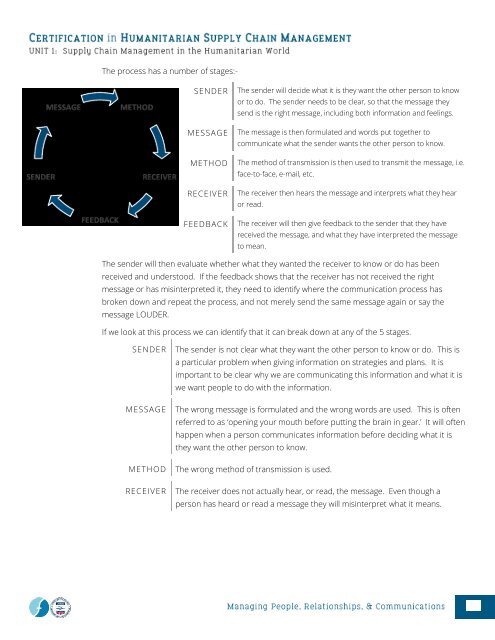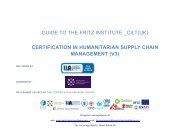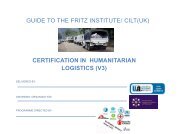CHSCM 3.0 - Unit 1 - SCM in the Humanitarian World
Learning Materials for Unit 1 of the Certification in Humanitarian Supply Chain Management (CHSCM).
Learning Materials for Unit 1 of the Certification in Humanitarian Supply Chain Management (CHSCM).
You also want an ePaper? Increase the reach of your titles
YUMPU automatically turns print PDFs into web optimized ePapers that Google loves.
The process has a number of stages:-<br />
SENDER<br />
MESSAGE<br />
METHOD<br />
RECEIVER<br />
FEEDBACK<br />
The sender will decide what it is <strong>the</strong>y want <strong>the</strong> o<strong>the</strong>r person to know<br />
or to do. The sender needs to be clear, so that <strong>the</strong> message <strong>the</strong>y<br />
send is <strong>the</strong> right message, <strong>in</strong>clud<strong>in</strong>g both <strong>in</strong>formation and feel<strong>in</strong>gs.<br />
The message is <strong>the</strong>n formulated and words put toge<strong>the</strong>r to<br />
communicate what <strong>the</strong> sender wants <strong>the</strong> o<strong>the</strong>r person to know.<br />
The method of transmission is <strong>the</strong>n used to transmit <strong>the</strong> message, i.e.<br />
face-to-face, e-mail, etc.<br />
The receiver <strong>the</strong>n hears <strong>the</strong> message and <strong>in</strong>terprets what <strong>the</strong>y hear<br />
or read.<br />
The receiver will <strong>the</strong>n give feedback to <strong>the</strong> sender that <strong>the</strong>y have<br />
received <strong>the</strong> message, and what <strong>the</strong>y have <strong>in</strong>terpreted <strong>the</strong> message<br />
to mean.<br />
The sender will <strong>the</strong>n evaluate whe<strong>the</strong>r what <strong>the</strong>y wanted <strong>the</strong> receiver to know or do has been<br />
received and understood. If <strong>the</strong> feedback shows that <strong>the</strong> receiver has not received <strong>the</strong> right<br />
message or has mis<strong>in</strong>terpreted it, <strong>the</strong>y need to identify where <strong>the</strong> communication process has<br />
broken down and repeat <strong>the</strong> process, and not merely send <strong>the</strong> same message aga<strong>in</strong> or say <strong>the</strong><br />
message LOUDER.<br />
If we look at this process we can identify that it can break down at any of <strong>the</strong> 5 stages.<br />
SENDER<br />
MESSAGE<br />
METHOD<br />
RECEIVER<br />
The sender is not clear what <strong>the</strong>y want <strong>the</strong> o<strong>the</strong>r person to know or do. This is<br />
a particular problem when giv<strong>in</strong>g <strong>in</strong>formation on strategies and plans. It is<br />
important to be clear why we are communicat<strong>in</strong>g this <strong>in</strong>formation and what it is<br />
we want people to do with <strong>the</strong> <strong>in</strong>formation.<br />
The wrong message is formulated and <strong>the</strong> wrong words are used. This is often<br />
referred to as ‘open<strong>in</strong>g your mouth before putt<strong>in</strong>g <strong>the</strong> bra<strong>in</strong> <strong>in</strong> gear.’ It will often<br />
happen when a person communicates <strong>in</strong>formation before decid<strong>in</strong>g what it is<br />
<strong>the</strong>y want <strong>the</strong> o<strong>the</strong>r person to know.<br />
The wrong method of transmission is used.<br />
The receiver does not actually hear, or read, <strong>the</strong> message. Even though a<br />
person has heard or read a message <strong>the</strong>y will mis<strong>in</strong>terpret what it means.
















